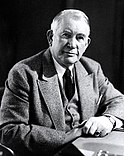Wikipedia:Today's featured article/March 2022
| << | Today's featured articles for March 2022 | >> | ||||
|---|---|---|---|---|---|---|
| Su | Mo | Tu | We | Th | Fr | Sa |
| 1 | 2 | 3 | 4 | 5 | ||
| 6 | 7 | 8 | 9 | 10 | 11 | 12 |
| 13 | 14 | 15 | 16 | 17 | 18 | 19 |
| 20 | 21 | 22 | 23 | 24 | 25 | 26 |
| 27 | 28 | 29 | 30 | 31 | ||
March 1
Hector Waller (4 April 1900 – 1 March 1942) was a senior officer in the Royal Australian Navy. Born in Benalla, Victoria, Waller entered the Royal Australian Naval College in 1913 and served in the First World War. He gained his first command in 1937, as captain of the destroyer HMS Brazen. In September 1939, he took command of HMAS Stuart and four other obsolete destroyers that together became known as the "Scrap Iron Flotilla". Waller was awarded the Distinguished Service Order and Bar, and twice mentioned in despatches, for his achievements in the Mediterranean. He then transferred to the South West Pacific as captain of the light cruiser HMAS Perth, and went down with his ship against heavy odds during the Battle of Sunda Strait in early 1942. He received a third mention in despatches posthumously, and in 2011 came under formal consideration for the award of the Victoria Cross for his performance as Perth's captain. The submarine HMAS Waller is named in his honour. (Full article...)
March 2
Greed is an American television game show that aired on Fox for one season. Chuck Woolery (pictured) was the show's host while Mark Thompson was its announcer. The series featured a team of contestants who answered up to eight multiple-choice questions for a prize of up to $2,000,000. Dick Clark and Bob Boden of Dick Clark Productions created it in response to the success of ABC's Who Wants to Be a Millionaire. Production was rushed so as to launch the show before Millionaire's new season, and the show premiered on November 4, 1999. While its Nielsen ratings were not quite as successful as Millionaire's, Greed still improved on Fox's performance year-to-year in its timeslots. Critical reception was mixed; some saw it as a clone of Millionaire, while others believed Greed was the more intriguing and dramatic of the two. The final episode aired July 14, 2000. Only one contestant advanced to the eighth question, but he failed to win the top prize. (Full article...)
March 3
Brownhills is a town and former administrative centre in the Metropolitan Borough of Walsall, England. Before 1974, it was in the county of Staffordshire. The town lies on the route of the ancient Watling Street. Although there is no record of its existence before the 17th century, Ogley Hay – a district of the town today – is recorded as a settlement in the Domesday Book. Brownhills quickly grew around the coal-mining industry, especially in the mid-19th century after the town was linked to the railway and canal networks. By the end of the century, Brownhills had grown from a hamlet of only 300 inhabitants to a town of more than 13,000, of whom the vast majority were employed in the coal industry. Mining remained the town's principal industry until the 1950s; the subsequent closure of the pits led to a severe economic decline that has continued until the present. The local authority instituted a regeneration programme in 2007, but there has been little subsequent development. (Full article...)
March 4
"A Death in the Family" is a 1988 storyline in Batman, an American comic book published by DC Comics. Written by Jim Starlin and penciled by Jim Aparo, it is considered one of the most important Batman stories as it features the death of his sidekick Robin at the hands of his archenemy, the Joker. Jason Todd, the second character to assume the Robin persona, was introduced in 1983 to replace Dick Grayson, but became unpopular among fans. Editor Dennis O'Neil recalled a 1982 Saturday Night Live sketch in which viewers phoned in, voting to boil or spare Larry the Lobster. Similarly, DC set up a 900 number to allow fans to decide Todd's fate, and fans voted to kill him off. Todd's demise had a lasting effect on Batman stories, pushing the comic-book mythos in a darker direction. It remains a popular story among readers and has been reprinted in trade paperback. An animated interactive-film adaptation, Batman: Death in the Family, was released in 2020. (Full article...)
March 5
The Röhm scandal was the public disclosure of the homosexuality of Nazi politician Ernst Röhm (pictured) by the Social Democratic Party of Germany (SPD). It began in April 1931, when the SPD newspaper Münchener Post published a series of front-page stories inaccurately portraying the Nazi Party as dominated by homosexuals. During the 1932 German presidential election, the SPD released a pamphlet edited by the ex-Nazi Helmuth Klotz with letters in which Röhm had discussed his homosexuality. On 12 May 1932, Klotz was beaten by Nazi deputies in the Reichstag building in revenge for his publication of the pamphlet, bringing the matter to national attention, and making Röhm the world's first openly gay politician. The Nazis' electoral performance was not affected by the scandal. Hitler defended Röhm, but had him murdered in 1934, citing both his homosexuality and alleged treachery. This purge began the systematic persecution of homosexual men in Nazi Germany. (Full article...)
March 6
Louis Rwagasore (1932–1961) served as Prime Minister of Burundi from 28 September 1961 until his assassination two weeks later. Born in Ruanda-Urundi, a Belgian-administered territory, Rwagasore attended university in Belgium. After he returned to Burundi in the mid-1950s, he founded a series of cooperatives to economically empower Burundians. He then became a leading figure of a nationalist political party, the Union for National Progress (UPRONA). He pushed for national independence and unity, and the institution of a constitutional monarchy. The Belgian administration placed Rwagasore under house arrest in 1960 during municipal elections. International pressure led the administration to back down, and the following year UPRONA won an overwhelming majority in the legislative elections. As a result, Rwagasore became the prime minister, but was soon assassinated at the direction of leaders of a rival political party with the probable support of the Belgian Resident. Well-known in Burundi, Rwagasore remains relatively unknown internationally. (Full article...)
March 7
Robert Roberts (1905–1974) was an English writer, teacher and social historian, noted for the evocative accounts of his working-class youth he gave in The Classic Slum (1971) and A Ragged Schooling (1976). Born and raised in a deprived district of Salford, Roberts left school at 14 for a seven-year apprenticeship as a brass finisher. Sacked once it ended, he spent three years unemployed, and attended evening classes. In 1929, he was hired as a teacher at a commercial college, but was dismissed in 1940 when he was exempted from conscription as a conscientious objector. He then spent years working as a farmhand, as well as teaching and writing. In 1957, he was hired to teach at Strangeways Prison in Manchester; his experiences there inspired his first book, Imprisoned Tongues (1968). In 1971, Roberts published The Classic Slum, a book about his boyhood, intermixed with social and oral history. Widely praised, it has become a key source for understanding the working-class experience in early-20th-century England. (Full article...)
March 8
The hartebeest (Alcelaphus buselaphus) is a large African antelope. Standing just over 1 m (3.3 ft) at the shoulder, it has a typical head-and-body length of 200 to 250 cm (80 to 90 in) and weighs 100 to 200 kg (220 to 440 lb). Coat colour varies among the eight subspecies, from the sandy brown of the western hartebeest to the chocolate brown of Swayne's hartebeest. Both sexes have an elongated forehead, back-curving horns, a short neck, pointed ears, and unusually long legs. Herds typically have up to 300 individuals, grazing mainly on grasses in dry savannas and wooded grasslands, and often moving to more arid places after rainfall. The hartebeest was formerly widespread in Africa, but populations have undergone drastic decline due to habitat destruction, hunting, human settlement, and competition with livestock for food. The species is extinct in Algeria, Egypt, Lesotho, Libya, Morocco, Somalia, and Tunisia, but has been reintroduced into Eswatini and Zimbabwe. (Full article...)
March 9
Racer's hurricane was a destructive tropical cyclone that affected Jamaica, northeastern Mexico, the Republic of Texas, and the Southeastern United States in September and October 1837, killing an estimated 105 people. It was named after the Royal Navy ship HMS Racer, which encountered the cyclone in the northwestern Caribbean Sea. Matamoros, on the southern bank of the Rio Grande, faced hurricane conditions for several days, with significant damage to ships. Towns along the Texas shoreline were inundated, and Galveston Island was devastated, with nearly every building washed away. A water-level rise of 8 ft (2.4 m) on Lake Pontchartrain wrecked buildings along its shores and submerged low-lying areas of New Orleans. As the weakening storm buffeted the Outer Banks of North Carolina on October 9, the passenger steamship SS Home ran aground off Cape Hatteras and broke up in the pounding surf (pictured), killing about 90 passengers and crew members. (Full article...)
March 10
The Singer Building was an early skyscraper in Manhattan, New York City. The headquarters of the Singer Manufacturing Company, it was at the corner of Liberty Street and Broadway in the Financial District. Architect Ernest Flagg designed it in multiple phases from 1897 to 1907, with elements of the French Beaux-Arts and Second Empire styles. When completed in 1908, the building had a marble-clad lobby, 16 elevators, 410,000 square feet (38,000 m2) of office space, and an observation deck. With a roof height of 612 feet (187 m), the Singer Tower was the tallest building in the world from 1908 to 1909, when it was surpassed by the Metropolitan Life Insurance Company Tower. The base occupied the building's entire land lot; the tower's floors took up just one-sixth of that area. Although regarded as a city icon, the Singer Building was razed between 1967 and 1969 to make way for One Liberty Plaza. At the time of its destruction, the Singer Building was the tallest building ever to be demolished. (Full article...)
March 11
The Draft Eisenhower movement was a widespread political movement to persuade Dwight D. Eisenhower to contest the presidency of the United States. Due to his popularity as Army chief of staff, he was widely expected to run in the 1948 election. Polls ranked him ahead of other candidates; he was approached by various politicians. James Roosevelt invited all the Democratic delegates to a caucus attempting to make a joint appeal, but Eisenhower refused to enter politics. In 1951, the draft movement re-emerged, while Eisenhower had not announced his political affiliation. Republican senator Henry Cabot Lodge Jr. managed his party's efforts to draft Eisenhower. On March 11, 1952, Eisenhower won the Republican primary in New Hampshire, and later agreed to run. Nominated by the Republicans, he won the 1952 election by a huge margin. The slogan "I like Ike" is associated with this movement (advertisement shown). The Draft Eisenhower movement has been referenced in various later draft movements. (Full article...)
March 12
Fakhr al-Din II (c. 1572 – 1635) was the paramount Druze emir of Mount Lebanon and the strongman over much of the Levant from the 1620s to 1633. For uniting Lebanon's constituent communities, he is generally regarded as the country's founder. Fakhr al-Din succeeded his father as the emir of the Chouf mountains around 1591, and the Ottoman Empire gave him control over other districts, but attacked him in 1613 for allying with Tuscany. He escaped into exile but returned in 1618, resuming control of his former domains and greatly expanding them in the following years. Despite the empire being in a long economic crisis, Fakhr al-Din's territories thrived. He promoted commercial agriculture, focusing on the lucrative silk trade of Mount Lebanon. He surrendered to the Ottomans during a siege of his Chouf hideout in 1633 and was executed in Constantinople in 1635. His main enduring legacy is the symbiotic relationship between Maronites and Druze, foundational for the creation of a Lebanese state. (Full article...)
March 13
Farran Zerbe (1871–1949) was an American coin collector and dealer who was the president of the American Numismatic Association (ANA) in 1908 and 1909. Born in Tyrone, Pennsylvania, he collected coins from childhood. He joined the ANA in 1900, and served as chief numismatist at the world's fairs at St. Louis (1904), at Portland (1905) and at San Francisco (1915). He exhibited his collection at banks across the U.S. beginning in 1907, the year he was elected ANA president, until he sold it to the Chase National Bank in 1928, thereafter serving as its curator. He purchased the journal of the ANA, The Numismatist, for himself from the widow of its founder in 1908. A factional fight in the ANA followed but Zerbe's chosen successor was elected. In 1969, he was posthumously inducted into the Numismatic Hall of Fame. The ANA's highest honor, awarded annually, had long been called the "Farran Zerbe Memorial Award", but the ANA removed his name from the honor in 2021. (Full article...)
March 14

A group, in mathematics, is a set together with an operation that combines any two of its elements to form a third element, in such a way that the operation is associative, an identity element exists, and every element has an inverse. These three conditions, called group axioms, are familiar from number systems. The ubiquity of groups in numerous areas—both within and outside mathematics—makes them a central organizational tool in contemporary mathematics. The concept of a group arose from the study of polynomial equations, starting with Évariste Galois in the 1830s. After contributions from other fields such as number theory and geometry, the group notion was generalized and firmly established around 1870. Today, group theory is a very active mathematical discipline that studies groups in their own right. Symmetry groups are widely applied in molecular chemistry and various physical disciplines. (Full article...)
March 15
On 15 March 1921, Armenian student Soghomon Tehlirian assassinated Talaat Pasha, a leading Ottoman politician and the main architect of the Armenian genocide, in Berlin. About a million Armenians died in the genocide, including most of Tehlirian's family. He joined a clandestine assassination campaign seeking revenge. Tehlirian's trial (pictured) was held on 2 and 3 June 1921, and the defense strategy was to put Talaat on trial for the Armenian genocide. Several eyewitnesses to the genocide testified, resulting in "one of the most spectacular trials of the twentieth century". Tehlirian claimed he had acted alone, telling a dramatic, but untrue, story of witnessing the deaths of his family members. He argued: "I have killed a man, but I am not a murderer", and the jury acquitted him. International news coverage brought attention to the facts of the Armenian genocide. The coverage inspired Polish-Jewish lawyer Raphael Lemkin to coin the term genocide and help codify it as a crime in international law. (Full article...)
March 16
The Colossus of Rhodes is a 1954 oil painting by the Spanish artist Salvador Dalí (pictured). One of a series of seven paintings created for the 1956 film Seven Wonders of the World, it shows the Colossus of Rhodes, the ancient statue of the Greek titan-god of the sun, Helios. Painted two decades after Dalí's heyday with the surrealist movement, The Colossus of Rhodes is emblematic of his transition from the avant-garde to the mainstream. After financial pressures imposed by his move to the United States in 1940, and influenced by his fascination with Hollywood, he shifted focus away from his earlier exploration of the subconscious and perception, and towards historical and scientific themes. His rendering of the Colossus is heavily influenced by a 1953 presentation by Herbert Maryon, a sculptor and conservator at the British Museum. None of the commissioned paintings were ultimately used for the film, and The Colossus of Rhodes was donated in 1981 to the Kunstmuseum Bern. (Full article...)
March 17
HMS Erin was a dreadnought battleship of the Royal Navy, originally ordered under the name Reşadiye by the Ottoman government from the British company Vickers. She was designed to be at least the equal of any ship afloat or under construction. Nearly complete when the First World War was beginning in August 1914, the ship was seized at the orders of Winston Churchill, First Lord of the Admiralty, to keep her in British hands and prevent her from being used by Germany or its allies. Aside from a minor role in the Battle of Jutland in May 1916 and the inconclusive Action of 19 August the same year, Erin's service during the war generally consisted of routine patrols and training in the North Sea. Deemed obsolete after the war, the ship was reduced to reserve and used as a training ship. Erin served as the flagship of the reserve fleet at the Nore sandbank for most of 1920. She was sold for scrap in 1922. (Full article...)
March 18
The Pali-Aike volcanic field is a volcanic field in Argentina that straddles the border with Chile. It is part of a family of back-arc volcanoes in Patagonia that formed from the collision of the Chile Ridge with the Peru–Chile Trench. There are approximately 467 vents in an area of 4,500 square kilometres (1,700 square miles). The field was first active 3.78 million years ago, and is noteworthy for the presence of large amounts of xenoliths in its rocks. The latest eruptions occurred during the Holocene, as indicated by the burial of archaeological artifacts; the Laguna Azul maar formed about 3,400 years before present. Humans have lived in the region for thousands of years, and a number of archaeological sites such as the Fell Cave are located in the field. Presently, parts of the volcanic field are protected areas in Chile and Argentina. The city of Río Gallegos in Argentina is within 23 kilometres (14 mi) of the volcanic field. (Full article...)
March 19
Fearless is the second studio album by American singer-songwriter Taylor Swift (pictured), released on November 11, 2008. Produced by Swift and Nathan Chapman, the album was written largely by Swift while she was promoting her 2006 self-titled debut album in 2007 and 2008. Fearless is a country pop record featuring traditional country instruments such as banjos. The lyrics explore themes of teenage romance, heartache, and aspirations. The album's title refers to the overarching theme of all of its tracks, which depict Swift gaining courage to embrace love's challenges. After the release of Fearless, Swift embarked on the Fearless Tour, which ran from April 2009 to July 2010. Two singles from the album, "Love Story" and "You Belong with Me", were successful on both country and pop radio. The album spent eleven weeks atop the US Billboard 200 and was certified diamond by the Recording Industry Association of America. (Full article...)
March 20
Synthetic diamond is diamond produced in a technological process. Claims of diamond synthesis were documented between 1879 and 1928 but none have been confirmed. In the 1940s, research began in the United States, Sweden and the Soviet Union to grow diamond using chemical vapor deposition (CVD) and high-pressure high-temperature (HPHT) processes. The first reproducible synthesis was in 1953. CVD and HPHT still dominate the production of synthetic diamonds, whose properties vary depending on the process used. The hardness, thermal conductivity and electron mobility of some manufactured diamonds are superior to those of natural diamonds. Synthetic diamond is used in cutting and polishing tools, abrasives and heat sinks. Electronic applications of synthetic diamond are being developed, including high-power switches at power stations, high-frequency field-effect transistors and light-emitting diodes. Both CVD and HPHT diamonds can be cut into gems and produced in various colors (pictured). (Full article...)
March 21
Computer Space is a space-combat arcade game released in 1971. Created by Nolan Bushnell and Ted Dabney in partnership as Syzygy Engineering, it was the first arcade video game and the first commercially available video game. In the game the player controls a rocket engaged in a missile battle against a pair of hardware-controlled flying saucers set against a starfield background. The goal is to score more hits than the enemy within a set time period. The game is enclosed in a custom fiberglass cabinet, which Bushnell designed to look futuristic. Bushnell and Dabney created the game to be a coin-operated version of Spacewar!, a 1962 computer game. They could not economically run the game on a general-purpose minicomputer, so they built specialized hardware for the game. They ran their first location test in August 1971, and it was shown to industry press and distributors at the annual Music Operators of America Expo in October. More than one thousand cabinets were sold by mid-1972. (Full article...)
March 22
Alben W. Barkley (1877–1956) was the 35th vice president of the United States, serving from 1949 to 1953. He was elected the U.S. representative from Kentucky's first district in 1912 as a liberal Democrat, supporting President Woodrow Wilson's New Freedom domestic agenda and foreign policy. In 1927 he entered the U.S. Senate, where he supported the New Deal, and was elected to succeed Joseph T. Robinson, Senate Majority Leader, upon Robinson's death in 1937. He resigned as majority leader after President Franklin D. Roosevelt ignored his advice and vetoed the Revenue Act of 1943, but the veto was overridden and he was unanimously re-elected to the position. Barkley had a better working relationship with Harry S. Truman, who ascended to the presidency after Roosevelt's death in 1945. At the 1948 Democratic National Convention, Barkley gave a keynote address that energized the delegates. Truman selected him as a running mate for the upcoming election, and the two scored an upset victory. (Full article...)
March 23
"SLAPP Suits" is a 2019 segment of HBO's news-satire television series Last Week Tonight with John Oliver, focusing on strategic lawsuits against public participation (SLAPPs), expensive lawsuits designed to scare targets into silence. In the segment, host John Oliver (pictured) celebrated his victory in a SLAPP initiated by Robert E. Murray; the lawsuit followed Oliver's criticism of Murray and his coal-mining company in a 2017 episode that included a man in a giant squirrel costume holding up an oversized check made payable to "Eat Shit, Bob!" Murray's lawsuit sought monetary damages and a gag order on the episode. The case was dismissed in under a year. In "SLAPP Suits", Oliver highlights Murray's frivolous suits against others, including reputable newspapers and private citizens, and stages a musical number titled "Eat Shit, Bob!", in which he jokingly accuses Murray of committing outlandish acts such as spitting on the Mona Lisa and shooting puppies into outer space. (Full article...)
March 24
The Seattle Center Monorail is an elevated straddle-beam monorail line in Seattle, Washington, United States. The nearly mile-long (1.4 km) monorail runs mostly along 5th Avenue between Seattle Center and Westlake Center in Downtown Seattle, making no intermediate stops. The monorail is a major tourist attraction but also operates as a regular public transit service with trains every ten minutes running for up to 16 hours per day. It was constructed in eight months for the 1962 world's fair, hosted at Seattle Center, and opened on March 24, 1962. The system retains its original fleet of two Alweg trains, each capable of carrying 450 people. The monorail's southern terminus was moved into Westlake Center in 1988 and the rest of the system was designated a historic landmark in 2003. The system remains under the ownership of the city government and is operated by a private company. Plans to expand the monorail's service area have been rejected or shelved several times since the 1960s. (Full article...)
March 25
Wie schön leuchtet der Morgenstern ('How beautifully the morning star shines'), BWV 1, is a church cantata for the Annunciation by Johann Sebastian Bach. He composed his chorale cantata in 1725, based on Philipp Nicolai's 1599 hymn, for the 25 March feast which coincided with Palm Sunday that year. The theme of the hymn suits both occasions, in a spirit of longing expectation of an arrival. The hymn was paraphrased by a contemporary poet who retained its first and last stanzas unchanged, set as a chorale fantasia and the closing chorale, but transformed the inner stanzas into a sequence of alternating recitatives and arias. Bach scored the work for three vocal soloists, a four-part choir and a Baroque instrumental ensemble of two horns, two oboes da caccia, two solo violins (part pictured), strings and continuo. It is the last chorale cantata of his second cantata cycle, begins the Bach-Gesellschaft's 1851 complete edition of his works and is listed as No. 1 in the 1950 Bach-Werke-Verzeichnis. (Full article...)
March 26
Jadran is a sailing ship for basic naval training built in Germany for the Royal Yugoslav Navy and currently in Montenegrin service. Commissioned in 1933, she completed seven long training cruises before World War II. During the war, she continued as a training ship, first by the Yugoslavians, but later by the Italians and then the Germans. Looted and dilapidated, she was returned to the new Socialist Federal Republic of Yugoslavia in 1946 and was rebuilt. Between 1949 and 1991, training was mainly conducted in the Adriatic, and she undertook only five long-distance cruises. When the Yugoslav Wars commenced in 1991, Jadran was homeported at Split but was undergoing a refit at Tivat in the Bay of Kotor and came under the control of rump Yugoslavia. In 2006, Montenegro became independent, and Jadran became a ship of the Montenegrin Navy. Her ownership remains disputed between Montenegro and Croatia; in December 2021, the two countries agreed to form a commission to settle the dispute. (Full article...)
March 27
Here Is Mariah Carey is a 1993 video album by American recording artist Mariah Carey. It presents her singing at Proctor's Theatre (pictured) in Schenectady, New York, and also includes non-concert footage. Carey performs ten songs; four are from her third studio album Music Box (1993), which her record label, Columbia, commissioned the hour-long video to promote. She is sporadically accompanied by a band, a choir, dancers, and string players. In creating the stage for the performance, production designers sought inspiration from works by Boris Aronson and Josep Maria Jujol. Television network NBC broadcast it on November 25, 1993, to an audience of 19 million. Columbia Music Video released it on VHS five days later to generally positive reviews from critics. It received a platinum certification from the Recording Industry Association of America and was one of the best-selling video albums of 1994 and 1995 in the United States. (Full article...)
March 28

Chagas disease is a parasitic disease which occurs in the Americas, particularly in South America. It is caused by a protozoan named Trypanosoma cruzi (pictured), which is transmitted to humans and other mammals primarily by blood-drinking insects of the subfamily Triatominae. Other forms of transmission are possible, such as ingestion of food contaminated with T. cruzi, blood transfusion and maternal–fetal transmission. After an initial stage of infection that is usually mild or asymptomatic, untreated individuals enter the chronic phase of the disease. People with chronic Chagas disease may develop organ dysfunction, which most commonly involves the heart or the digestive system. Chagas disease can be treated using the antiparasitic drugs benznidazole and nifurtimox, which are most effective in the early stage of infection. It is estimated that 6.5 million people worldwide are living with the disease, and it is responsible for about 9,490 annual deaths. (Full article...)
March 29
It's Elementary: Talking About Gay Issues in School is a 1996 American documentary film directed by Debra Chasnoff and Helen Cohen. It provides educators with information on how to teach elementary school children to be tolerant of gay and lesbian people. The film was noted as the "first of its kind" and was generally well received, although there was some backlash from conservatives. It was released in several film festivals and had screenings in the 2000s. It's Elementary did not receive much support from PBS due to backlash from the American Family Association. Prior to airing the film, television stations received calls, letters, and e-mails from people who did not want PBS program directors to broadcast it. The film was awarded the GLAAD Media Award for Outstanding Documentary, Best Documentary at the Reeling Film Festival, and the Silver Spire at the San Francisco International Film Festival, among other awards. The film had two sequels: That's A Family! and It's Still Elementary. (Full article...)
March 30
The Yankee was one of America's first cultural publications and a precursor to the independent American press that formed decades later. Founded and edited by John Neal (pictured), it was published in Portland, Maine, between 1828 and 1829. The magazine helped establish the American gymnastics movement, covered national politics, and critiqued American literature, art, theater, and social issues. Many new, predominantly female, writers and editors started their careers with publication and coverage in The Yankee, including many who are familiar to modern readers. Essays by Neal on American art and theater anticipated major changes and movements realized in the following decades. His articles on women's rights and early feminist ideas affirmed intellectual equality between men and women and demanded political and economic rights for women, saying "If woman would act with woman, there would be a stop to our tyranny". (Full article...)
March 31
Operation Mincemeat was a successful British deception operation of the Second World War. In 1943, the body of Glyndwr Michael was dressed as an officer of the Royal Marines, and items were placed on him identifying him as the fictitious Captain William Martin. Correspondence between two British generals suggesting that the Allies planned to invade Greece and Sardinia, with merely a feint at Sicily, was also planted. The body was taken by the submarine HMS Seraph to the southern coast of Spain and released close to shore, where it was picked up later that morning by a Spanish fisherman. The nominally neutral Spanish government shared copies of the documents with German military intelligence, before returning them to the British. Ultra decrypts of German messages showed that the Germans fell for the ruse. Reinforcements were shifted to Greece and Sardinia before and during the invasion of Sicily; Sicily received none. The body was buried with military honours in Spain (grave pictured). (Full article...)
























